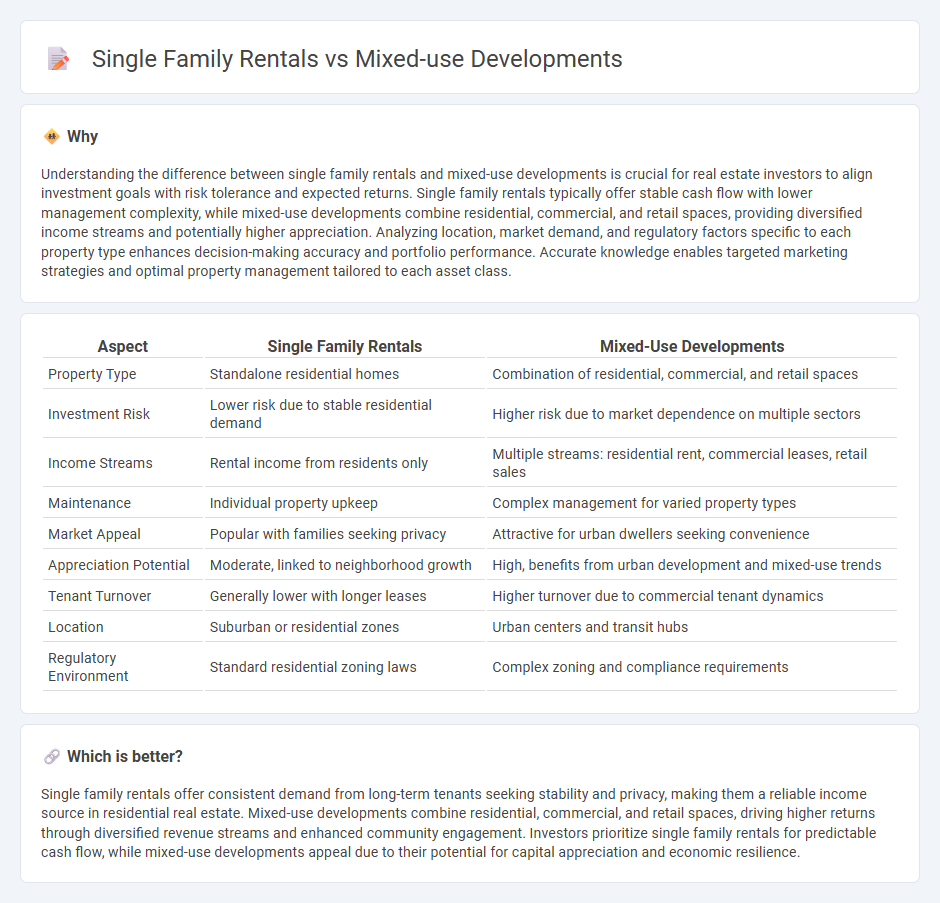
Single family rentals offer stable income streams and appeal to long-term tenants seeking privacy and community living. Mixed-use developments combine residential, commercial, and sometimes industrial spaces, maximizing property value and fostering vibrant, walkable neighborhoods. Explore the advantages and challenges of each to determine the best investment strategy for your real estate portfolio.
Why it is important
Understanding the difference between single family rentals and mixed-use developments is crucial for real estate investors to align investment goals with risk tolerance and expected returns. Single family rentals typically offer stable cash flow with lower management complexity, while mixed-use developments combine residential, commercial, and retail spaces, providing diversified income streams and potentially higher appreciation. Analyzing location, market demand, and regulatory factors specific to each property type enhances decision-making accuracy and portfolio performance. Accurate knowledge enables targeted marketing strategies and optimal property management tailored to each asset class.
Comparison Table
| Aspect | Single Family Rentals | Mixed-Use Developments |
|---|---|---|
| Property Type | Standalone residential homes | Combination of residential, commercial, and retail spaces |
| Investment Risk | Lower risk due to stable residential demand | Higher risk due to market dependence on multiple sectors |
| Income Streams | Rental income from residents only | Multiple streams: residential rent, commercial leases, retail sales |
| Maintenance | Individual property upkeep | Complex management for varied property types |
| Market Appeal | Popular with families seeking privacy | Attractive for urban dwellers seeking convenience |
| Appreciation Potential | Moderate, linked to neighborhood growth | High, benefits from urban development and mixed-use trends |
| Tenant Turnover | Generally lower with longer leases | Higher turnover due to commercial tenant dynamics |
| Location | Suburban or residential zones | Urban centers and transit hubs |
| Regulatory Environment | Standard residential zoning laws | Complex zoning and compliance requirements |
Which is better?
Single family rentals offer consistent demand from long-term tenants seeking stability and privacy, making them a reliable income source in residential real estate. Mixed-use developments combine residential, commercial, and retail spaces, driving higher returns through diversified revenue streams and enhanced community engagement. Investors prioritize single family rentals for predictable cash flow, while mixed-use developments appeal due to their potential for capital appreciation and economic resilience.
Connection
Single family rentals contribute to the diversification of mixed-use developments by providing residential options alongside commercial and retail spaces, enhancing community vibrancy. This integration supports urban density goals and creates seamless living environments that attract a variety of tenants. Real estate investors benefit from mixed-use projects by capturing income streams from both residential single family rentals and commercial leases.
Key Terms
Zoning
Zoning regulations play a pivotal role in shaping mixed-use developments and single-family rentals by defining permissible land uses, density, and building forms. Mixed-use developments often benefit from flexible zoning that encourages a blend of residential, commercial, and recreational spaces, fostering vibrant communities and walkability. Explore zoning impacts in detail to understand how they influence property value and urban planning strategies.
Density
Mixed-use developments maximize urban density by integrating residential, commercial, and recreational spaces within a compact footprint, promoting efficient land use. Single family rentals typically contribute to lower density patterns, favoring suburban sprawl with separated residential zones. Explore how density impacts community sustainability and investment potential in property portfolios.
Tenant Mix
Mixed-use developments offer a diverse tenant mix by combining residential, commercial, and retail spaces, promoting dynamic community interaction and higher foot traffic. Single-family rentals typically focus on homogeneous residential tenants, providing stability but limited commercial synergy. Explore how tenant mix influences investment strategies and community benefits in property development.
Source and External Links
Supporting Active Living Through Mixed-Use Developments - This resource explores how mixed-use developments can promote physical activity by integrating multiple uses within walking distance, offering environmental, economic, social, and health benefits.
Benefits of Mixed-Use Development in Urban Areas - Mixed-use developments provide a solution for efficient urban planning by combining residential, commercial, and sometimes industrial spaces to foster vibrant communities and sustainable growth.
8 Different Types of Mixed-Use Development - This guide outlines various types of mixed-use developments, including vertical, horizontal, and transit-oriented developments, highlighting their contributions to dynamic and sustainable urban environments.
 dowidth.com
dowidth.com